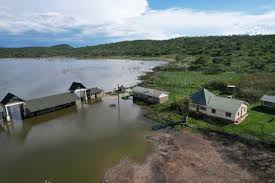Kenya’s Lake Baringo and Lake Bogoria, long celebrated for their beauty, wildlife, and cultural importance, are undergoing a dramatic and unsettling transformation. Over the past few years, both lakes have expanded rapidly, swallowing homes, roads, businesses, tourist facilities and grazing land, and forcing thousands of families to relocate.
What was once considered shoreline is now underwater. Schools, churches, health facilities, and entire villages have disappeared beneath the steadily advancing waters. Scientists, communities, and government agencies are racing to understand and respond to the crisis.
Lake Bogoria, famous for its hot springs, geysers, and flamingo populations, has grown from about 34 square kilometers to over 45. Nearby, freshwater Lake Baringo has risen more than 15 meters during recent rainy seasons. The expansion has been so rapid that in some areas, locals have had to move more than once as waters continue creeping inland.
The results are impossible to ignore. Roads have become impassable, tourism businesses have closed, and fishing, farming, and pastoral livelihoods have been disrupted. In total, tens of thousands of people have been affected.
According to researchers, several factors both natural and human-made are converging: The Rift Valley has experienced a shift in rainfall patterns. While the number of rainy days has decreased, single rain events have become heavier and more intense. As a result, more water rushes into the lakes in a shorter time, leading to dramatic increases in water levels.
Decades of deforestation, overgrazing, and poor land management have left the surrounding terrain vulnerable to erosion. Heavy rains now wash large amounts of soil into the lakes, making them shallower. With reduced capacity, they flood more easily.
The lakes lie inside the active Great Rift Valley system. Geological shifts beneath the region can alter lake basin shapes and water retention, contributing to water level changes.
Together, these forces have created a powerful environmental shift one that communities were unprepared for. The rising waters have inflicted steep social and financial losses.
In Lake Bogoria, tourism—once the county’s lifeblood—has been hit hardest. Lodge owners and small businesses have shut down after their buildings were engulfed. The disappearance of some flamingo feeding grounds, due to changes in the lake’s chemistry, has only deepened the crisis.
In Lake Baringo, the scene is equally dire. Homes have vanished, schools have closed, and grazing lands have disappeared. Some communities now live in temporary camps, waiting for long-term relocation plans. Access to healthcare, markets, and transport has become increasingly difficult, especially where roads have been submerged.
Even wildlife is at risk. With rising waters pushing crocodiles and hippos closer to human settlements, encounters and conflicts are becoming more frequent.
One of the most worrying scientific possibilities is that Lake Bogoria could eventually overflow into Lake Baringo, mixing two very different water systems one saline, the other freshwater. Such a merger could radically change ecological conditions, destroy flamingo habitats, and damage fish populations.
Researchers warn that without serious intervention, the region could see irreversible environmental and cultural loss.
National and county agencies, alongside scientists and NGOs, have begun implementing mitigation and adaptation measures, including; Climate and hydrological monitoring, soil recovery and tree-planting programs, disaster preparedness planning, multi-agency studies on long-term solution, support for displaced households, environmental education and land-use reform.
Still, progress has been slow. With lake levels continuing to rise, stakeholders agree that Kenya must invest more aggressively in climate adaptation, land restoration, and community resilience.
For now, the people of Baringo live in a landscape shifting beneath their feet. Fishermen still launch boats at dawn, flamingos still color the horizon, and children still play near the water’s edge. But every passing season brings new change, new uncertainty, and new challenges.
What once seemed permanent, shorelines, villages, livelihoods is no longer guaranteed.
As the waters continue to rise, one question grows more urgent. How does a community adapt when the land itself is disappearing?
Only time and action will tell.


